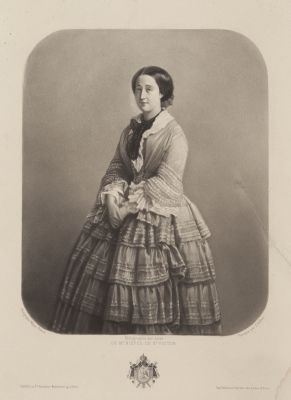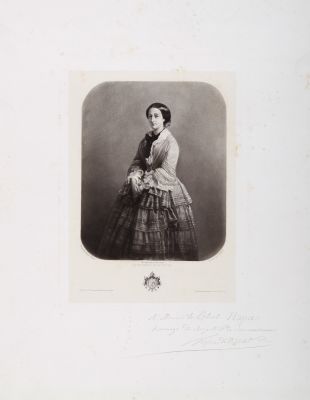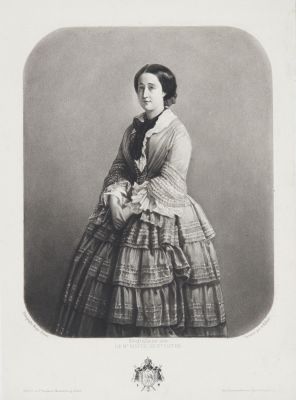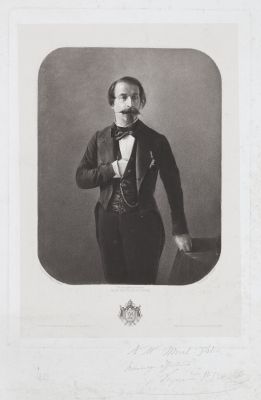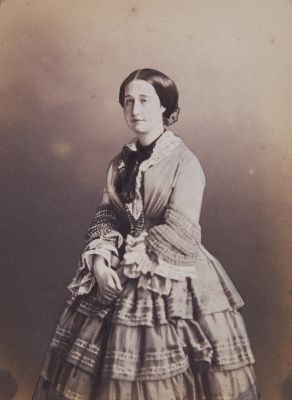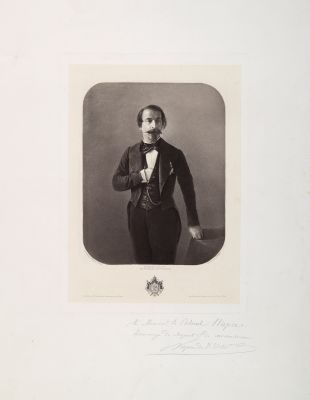
Title
Napoleon IIIArtist
Mayer Frères (French, 1805-1870)Date
1854Process
Photogravure (heliograph)Atelier
Niepce de Saint-VictorImage Size
18 x 14 cm
Beginning in 1853, Niépce de Saint-Victor and the engraver Francois-Augustin Lemaître worked to improve aspects of Joseph Nicéphore Niépce’s heliographic technique. The collaborative effort successfully yielded an improved technique that for the first time, allowed photographs to be translated into a printing plate. Their two principal refinements were making the bitumen of Judea more sensitive and adding an aquatint texture to hold the ink in large areas of tone. The process, however, produced images which were mostly unable to render delicacy of detail without the aid of extensive hand work. While it was clearly a photomechanical breakthrough, Niépce de Saint-Victor’s method did not last for very long, in particular because the process always required the intervention of an engraver. Its merit was that it was a pioneering method and opened the way to newer methods.
In 1854 Niépce de Saint-Victor presented to Emperor Napoleon III a sample of his heliogravure process. On July 7, 1854 Chevreul, under the title of ‘Considerations on Photography from an abstract point of view’, communicated new and highly interesting experiments made under his direction, at the Gobelins laboratory, by M. Niepce de Saint-Victor…"The reproductions and the experiences communicated today are the first fruit of the noble leisure activities which the high protection and the firm will of the Emperor have created for him. A few more days and M. Niepce will place in the hands of His Majesty a glorious testimony of his gratitude. It is a magnificent portrait of Napoleon Ill, photographically engraved on steel, by means of a negative by MM. Mayer brothers, for whom the Emperor has deigned to pose." [1]
In 1855 Niepce de Saint Victor worte in La Lumier, Such are the facts that are incident to the question of heliographic engraving ; and if, in spite of the immense step it has made in one year, it has not yet arrived at the degree of perfection that I hope to see it attain some day, its actual state can be judged of by the portrait of the Emperor Napoleon III… Niepce de Saint Victor. 1855 Essay on heliographic engraving on steel and glass. [2]
Leopold Ernest Mayer and his brother Louis Frederic started a daguerreotype studio in Paris about 1841-2. In February 1850 they established a joint firm under the name ‘Mayer freres’ at the Rue Vivienne, close to the Boulevard Montmartre, where they took daguerreotype and calotype portraits, the latter under the euphemistic title ‘daguerreotypie sur papier’. In May 1853 they took a portrait of Napoleon III which earned them the suffix ‘Photographers of his Majesty the Emperor’. Their association in November of the following year with Pierre Louis Pierson, a daguerreotypist who began work about 1844 and who had a studio in the Rue de Richelieu, led to the firm’s new title ‘Mayer et Pierson’. Each partner, however, kept his seperate studio going at the previous address. although all future work was produced under their joint names. [3]
Reproduced / Exhibited
Jammes, André, De Nieìpce AÌ Stieglitz: La Photographie En Taille-Douce : [exposition], 19 Novembre 1982-20 Feìvrier 1983, Museìe De L’elyseìe, Lausanne. Lausanne: Le Museìe, 1982 no. 28
De Andere Fotografie de Geschiedenis van de Fotomechanische Reproductie in de Negentiende Eeuw: tentoonstelling in het Zeeuws Museum Middelburg 1989 (The Other Photography the History of Photomechanical Reproduction in the Nineteenth Century: Exhibition in the Zeeuws Museum Middelburg 1989) Exhibited chk. 21
McCauley, Elizabeth Anne, AAE Disdéri and the business card portrait photograph, New Haven: Yale University Press, 1985.
References
[1] Cosmos : revue encyclopédique hebdomadaire des progrès des sciences et de leurs applications aux arts et à l’industrie, Bureaux du Cosmos, Paris, 1852 p. 274
[2] (from La Lumiére) in The Photographic and Fine Art Journal [8:1 (January), pp. 6-8]
[3] Gernsheim, Helmut. The Rise of Photography, 1850-1880: The Age of Collodion. London: Thames and Hudson, 1989.
Jammes, André, De Nieìpce AÌ Stieglitz: La Photographie En Taille-Douce : [exposition], 19 Novembre 1982-20 Feìvrier 1983, Museìe De L’elyseìe, Lausanne. Lausanne: Le Museìe, 1982 no. 28
Provenance is duc de Luynes
Lit : La Lumière (7 oct. 1854)
